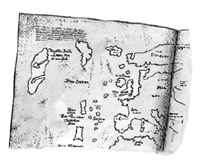
|
|
Viking Deception, The
|

|
|
Program Overview
|

|
 NOVA investigates the history and authenticity of the Vinland Map, a
document believed by some to be the first to depict America, and to
date to 1440, half a century before Columbus' famous voyage.
NOVA investigates the history and authenticity of the Vinland Map, a
document believed by some to be the first to depict America, and to
date to 1440, half a century before Columbus' famous voyage.
The program:
-
recounts the Vinland Sagas, 13th-century chronicles that relate
Leif Erikson's discovery of Vinland, an island named after the
vines found growing there.
-
reports how the Vinland Map first came to light in 1957 when an
Italian book dealer tried unsuccessfully to authenticate a world
map bound in a 15th-century manuscript titled the
Tartar Relation.
-
notes that the map indicates an island labeled Vinland located
at approximately where North America would be and includes a
short description that details the island's discovery by the
Vikings.
-
details how the manuscript was sold to an American dealer who
used watermarks and worm holes to try to date the Tartar
Relation and the map.
-
describes how the discovery of a manuscript titled the Speculum
Historiale led to the belief—confirmed by the location of
worm holes—that the Speculum, the Vinland Map, and the
Tartar Relation had once all been part of the same medieval
volume.
-
relates Yale University's subsequent purchase and unveiling of
the map.
-
reports on archeological finds from a fishing village in
Newfoundland that provided evidence that the Vikings had reached
North American shores prior to Christopher Columbus.
-
notes that when scholars questioned the map's genuineness, Yale
officials agreed to scientific tests to verify the map's
authenticity.
-
reviews the testing of the map's ink, including analyzing the
ink under different lights and microscopes, comparing it to
medieval inks, testing it at the atomic level, and subjecting it
to microprobe spectroscopy.
-
notes that evidence indicated that the map was a forgery.
-
concludes with a proposed suspect who might have created the
map—an Austrian Jesuit priest and map authority who may
have made the map as a private exercise, thinking that it should
exist but never believing it would be seen by others.
Taping Rights: Can be used up to one year after the program
is taped off the air.
|

|
